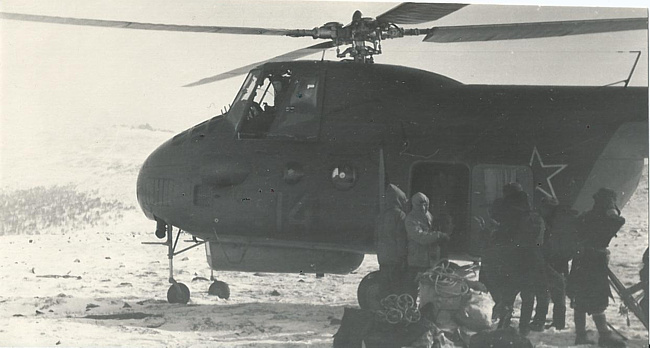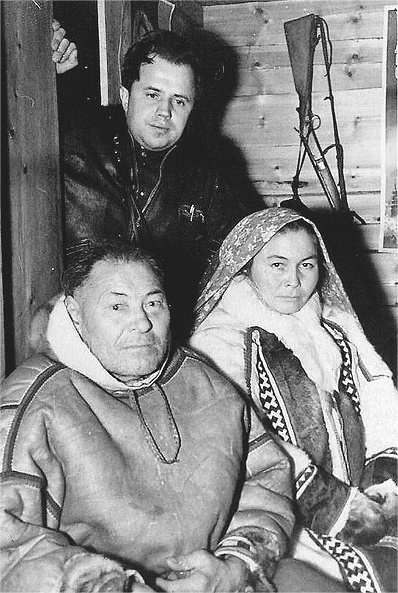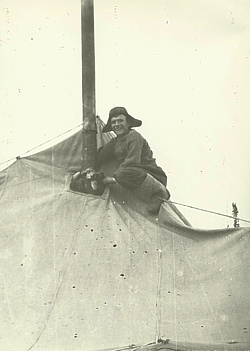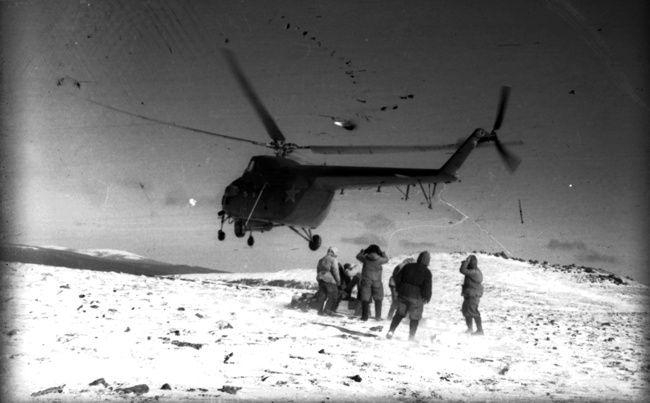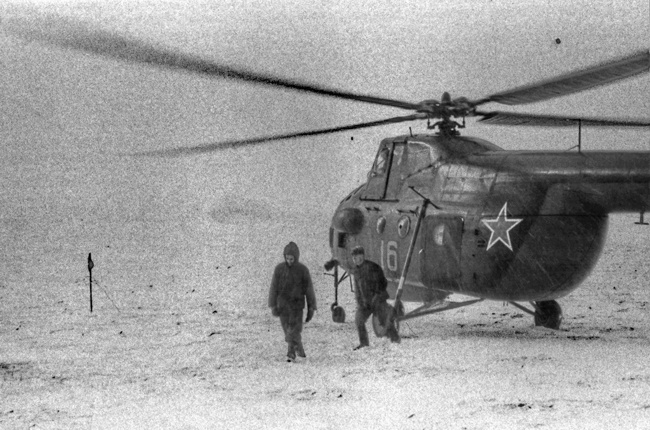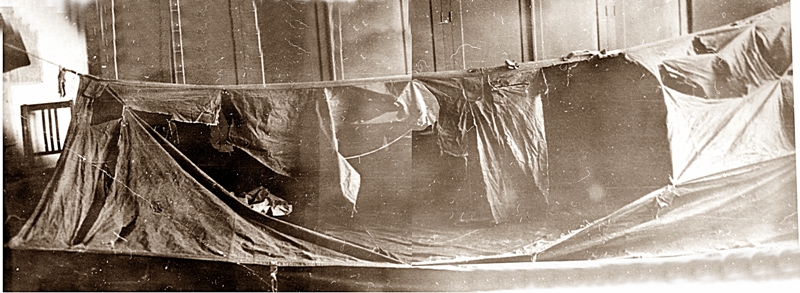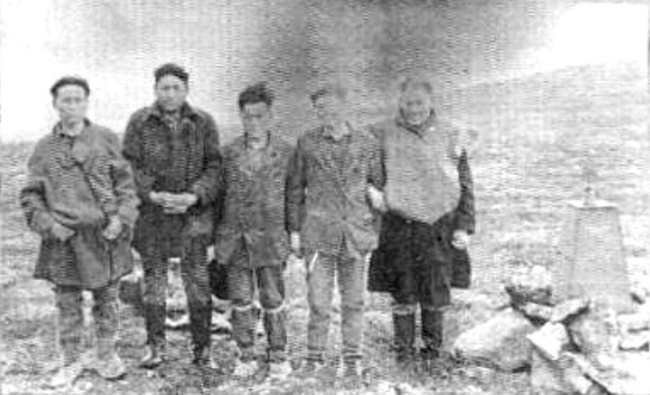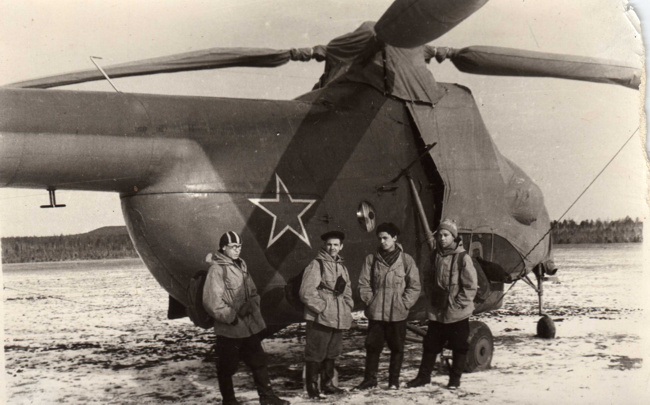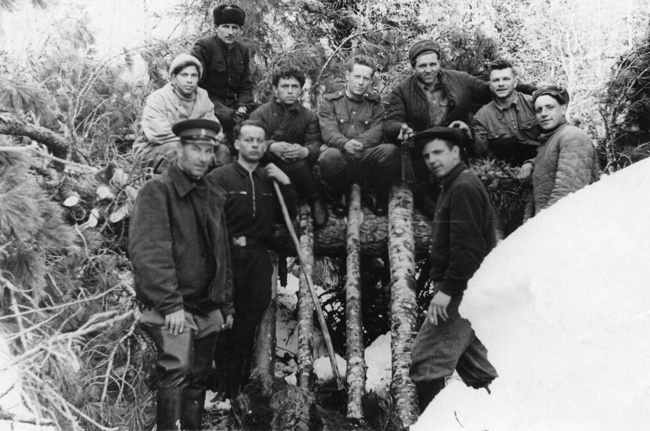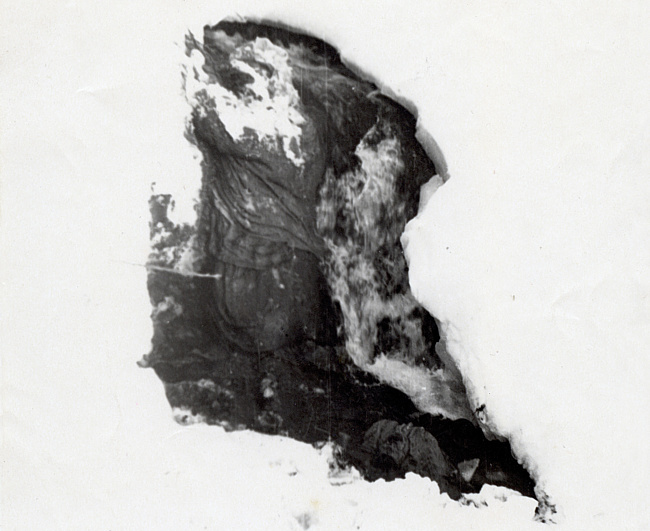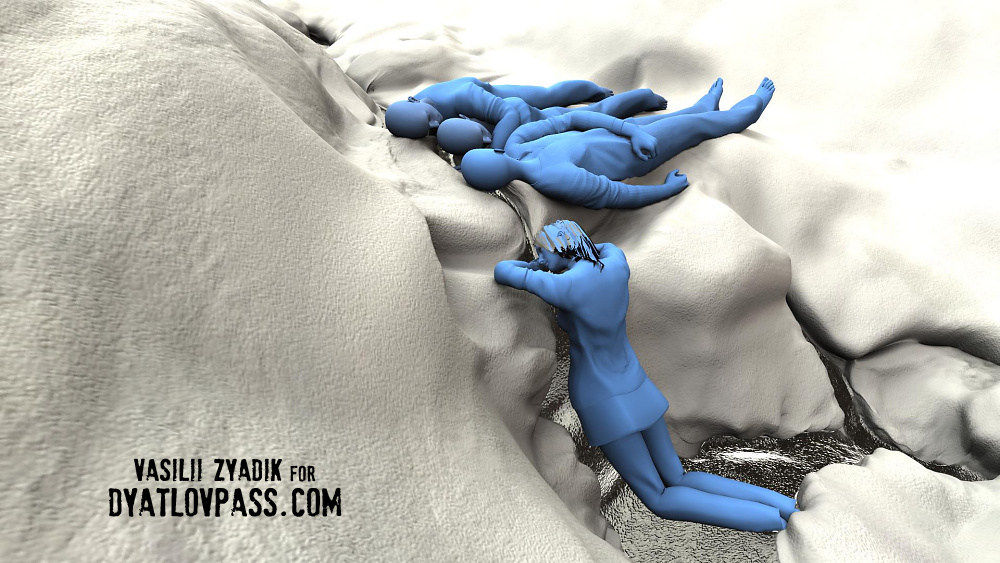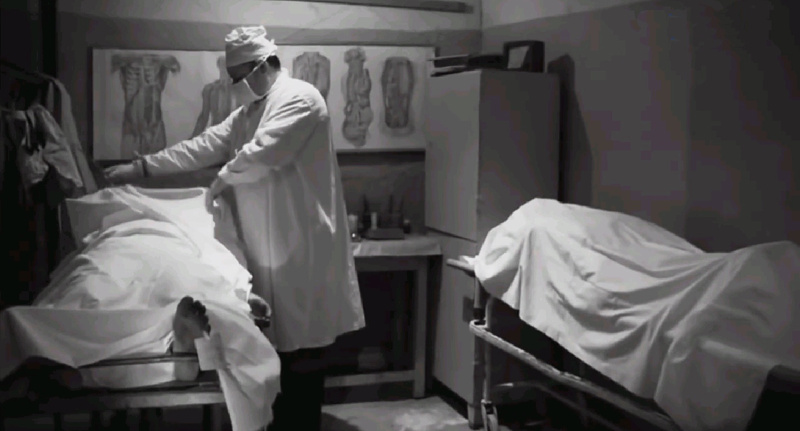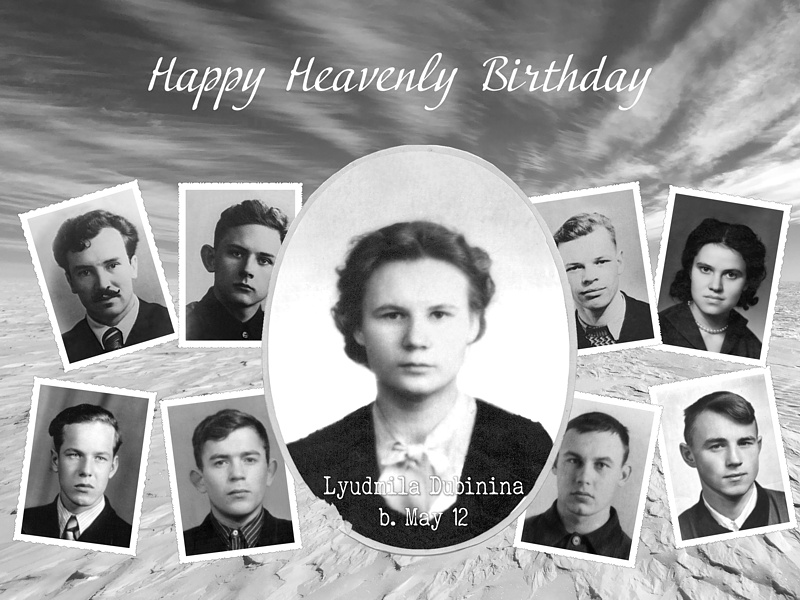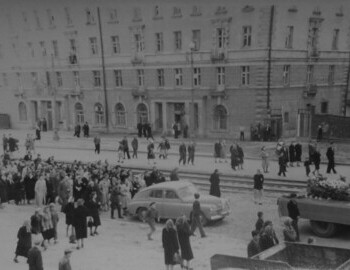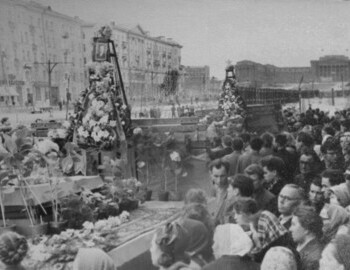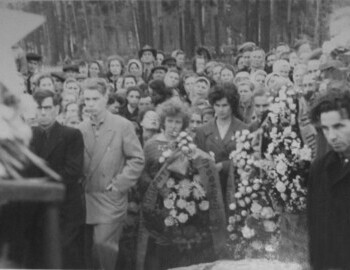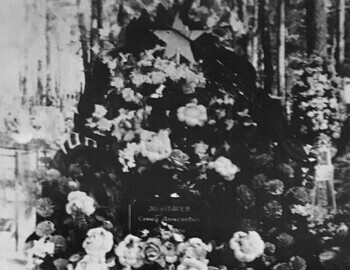
Chronology part 3 - Second group of bodies
Excerpts © "1079 The overwhelming force of Dyatlov Pass"
On March 13, a group of UPI mountaineers, including Abram Kikoin, Vladimir Krylov, Pyotr Bartolomey, Yuri Sahnin, Vladislav Shkodin, Stanislav Mertsalov, Gennadiy Solovyov, Yuri Smirnov, and Yuri Kotenev, flew from Ivdel to the mountain pass to relieve the tired soldiers in Potapov’s and Avenburg’s groups.
Bartolomey later recalled that, before the flight, Lev Ivanov asked for identification of the tent and personal belongings of the Dyatlov group, at that time stored at the Ivdel airport. According to Sahnin, Zolotaryov’s mother saw the rescue team off to the helicopter, while Zolotaryov’s nieces remembered that, following the news of her son’s death, Vera Ivanovna Zolotaryova was summoned to Sverdlovsk. It was her first air flight, which she boarded alone, as Aleksey Gerasimovich, Zolotaryov’s father, was not in good health at the time.
It took several days for the rescue team to depart from Ivdel. They boarded the helicopter a few times but were offloaded each time due to bad weather conditions. Along with the Kikoin group, Ortyukov, Prodanov, and Grigoriev, a reporter from the Urals Worker, were also flying to the pass. That morning Grigoriev begged the staff members to let him fly to the rescue camp at the pass. Prodanov and Ortyukov returned to Ivdel in the evening, while Grigoriev stayed back at the camp, so in total there were 13 men in the tent: Grigoriev, Nevolin, Korolyov, and the members of Kikoin’s group.
From Grigoriev’s diary: "We were talking about the deceased throughout the whole evening. About why they had pitched their tent on the mountain, etc. It was said that Igor Dyatlov was very ambitious, prone to domineering. At one point he suggested to his group to cross from one bank of the river to another, without any reason – with no reason at all. At one point the people were so outraged with his behavior that they would not follow his orders. Then he retreated and declared a hunger strike. He was a good and diligent rank-and-file member of the group. All mistakes were attributed to him. Two people who happened to be with him spoke about it in particular. Kikoin as well spoke negatively about him. He said that it was stupid, that the group left at 3 pm when it would get dark here in about an hour and a half or two." Grigoriev's "Snowstorm in the Mountains" - 3
On March 14 Grigoriev, who went on the search as part of a group of nine, discovered an old reindeer skin in the snow near a cedar tree. To his surprise, he was left to dig it out on his own, as the students would not help him, and it was his opinion that the students were searching half-heartedly.
From Grigoriev’s diary: "We walked a lot, but searched unsystematically and without a plan. The mood of students and the leader is bad. They were invited to relocate the camp to the valley of the Lozva river so as not to spend half the time on the crossings. But they did not do it. We decided to serve 10 days in the form of hiking back and forth. Cowards. When I found something soft near that cedar and began to dig one and a half meter of snow, at first one student decided to help me, but when I got closer to the ground, he ran away. It was hide covered with (thick) moss." Grigoriev's "Snowstorm in the Mountains" - 3
Besides the search works, Kikoin’s group was offered to move the camp to the valley of the Lozva River, but this was not done, either. On the other hand, immediately upon their arrival at the pass, the mountain climbers ascended height 1079. With one group after another returning from their search without any result, the students were seriously discouraged and on numerous occasions tried to convince their higher-ups that there was no point in continuing the search until the snow had melted down for good, but to no avail. Hence, they were not demonstrating great zeal in performing their duties, and that mood held until May.
At 11:30 am on March 15, under a heavy snowstorm, a group of military servicemen, together with a stove pipe and other camp equipment, arrived at the camp. Grigoriev, Korolyov, and Nevolin, who was to be replaced by another radio operator, returned to Ivdel.
From Grigoriev’s diary: "He went against the wind that blew on the rocks. Then he landed on gas, the wheels jumped, the wind blew away the helicopter. The engine and the wind roared. Soldiers quickly jumped out of it, one carrying a pipe for the stove, so that build it up in a tent. Wind and a stream of air from the huge propeller knocked down the soldier with the stovepipe, the pipe jumped over the stones. Then we ducked into the jumping helicopter, removing the footboard and slamming the door on the fly. The second helicopter made several attempts, but could not land. Protyazhenko landed." Grigoriev's "Snowstorm in the Mountains" - 3
The sparks from the stove were burning holes in the tent and when the sun was shining through, Nevolin said "we live in a planetarium". You can see the holes in the photo. An example of how the photos are dated - before this photo the stove pipe sticking out of the tent is short, which means this is the divider before and after March 15. Small details like this is how we do the sleuthing of the Dyatlov Pass incident. This same pipe was first photographed in modern days Yudin and Koskin, and then found again by Oleg Taymen in 2023. See photos
The photos are from where the winter camp was relocated in April, on the north side of the pass, closer to the Cedar. It was very exhausting everyday for the searcher to have to go over the pass several times to work, so the camp was moved closer to where the bodies were expected to be.
On March 18, the railway sappers of Senior Lieutenant Avenburg returned to search. Savelyev, Tymkov, Golubev, Vasilchenko, and Mordonov were joined by privates of the mine blasting platoon R. Hisamatullin, T. Faizov, and Petrosyan. They would remain at the pass until April 9.
On March 22, the third UPI search shift, consisting of Sergey Sogrin, Vitaliy Malyutin, Rudolf Sedov, Vasiliy Shulyatiev, Victor Meshtiryakov, Victor Eroshev, Valeriy Dubovtsev, Valentin Yakimenko, and Boris Sychev, departed from Sverdlovsk by train after receiving instructions on safety arrangements at the UPI.
For a few days, the weather in Ivdel did not permit flying, and Kikoin’s group could not be removed from the pass. Sahnin would later recall that, during the whole period of the search, there was only one day without a strong wind or a blizzard. The group inspected the site west of the cedar, the slope, and the creek. In the creek, they were neck-deep in the snow but were unable to reach solid bottom, as their gauge feelers were not long enough. According to Nikolay Vasilyevich Tokarev – a civilian serving in military unit 6602, Ivdel’s champion in skiing and participant in the Potapov’s search group – he tried to draw Kikoin’s attention to broken fir-trees along the forest edge, but Kikoin took no notice. Later, in May, the final four bodies would be discovered precisely in the creek, in the vicinity of that site.
On March 25, the military and civil rescue members were replaced. Borey was replaced by Potapov as chief of the group from military unit 6602. The group also included Victor Klimenko, Nikolay Kuzminov, and Yuri Zauzin, secretary of the unit’s Komsomol organization.
Yakimenko later remembered that, when Sogrin’s team arrived at the rescue camp, part of the group of mountaineers were still there, waiting to board the helicopter’s second flight in a few hours. They cooked dinner together, but the students and soldiers kept apart, with practically no intermingling. Someone from among the mountaineers drew the newcomers’ attention to the hooks from the Dyatlov group’s equipment on the crossbeam over the fire.
The Mansi men were absent during the ground search. The rescue team was comprised of squads from the 6602 military unit led by Borey with a strength of 6, Avenburg’s group of sappers with a strength of 9, and Sogrin’s group with a strength of 10. Overall leadership was exercised by Captain Chernyshev. Probing was made along the slope of height 1079 in the direction of the forest, parallel to the "tent-cedar" line south of the site where the tent had been found. The site to the north, closer to the location of the tent, had already been explored by the previous rescue groups. The locations of the discovered bodies were identified with short gauge feelers driven into the snow.
Sychev would recall that they were walking on the solid crust with 2.5-meter-long (8 feet) wire gauge feelers, poking the ground in case they found something. If that happened, they would start digging with shovels. To avoid any potential traumas, the rescue teams were forbidden to climb the slope up to the location of the tent or to go further than 300 meters (984 feet) from the search zone.
The following information was received at the radio station of the Northern expedition: "To Prodanov and Vishnevskiy, March 31, 1959, 9:30 am local time: At 4:00 am on March 31, a hiker on duty named Meshtiryakov spotted a large flame-colored ring in the eastern direction, which for 20 minutes was moving in our direction and then hid behind height 880. Before hiding below the horizon, a star emerged from the center of the ring, which was gradually increasing up to the size of the Moon, and then began falling while separating from the ring. The entire contingent, alerted by the alarm, was watching the strange phenomenon. We are asking to explain this activity and its security since in given circumstances this is making a disturbing impression. Avenburg, Potapov, Sogrin"
"The Ivdel paper, Severnaya Zvezda (Northern Star), wrote about long-lasting northern lights to the north-east from Ivdel in the night from February 16 to February 17 from 11 pm to 5:30 am local time"
Another clip from
On April 6, Nikolay Kuzminov took charge of the rescue group of military unit 6602, and Sogrin’s group was replaced by the UPI fourth rescue group shift, consisting of Boris Martyushev, Evgeniy Zinovyev, Valeriy Pechenkin, Mihail Sharavin, Yuri Koptelov, Igor Shestopalov, and Anatoliy Plastun. As Plastun would later recall, enlistment in the rescue group was organized by means of a notice at the UPI hiking club. The rescue group, which was to serve as a cross-functional team, was brought to the pass by a helicopter, the same helicopter then taking the previous group back. In the interim, Yakimenko told Plastun that some kind of strange star was flying over their heads that night.
Тhe rescue team was put up below the river, in a large 30-berth tent together with the military rescuers. An officer from the military group served as coordinator of the search mission. On the slope, everything had been blown down by the winds, but traces of the tent site were still visible. The search mission followed those traces, along the slope closer to the cedar, but with no result. The weather was fine, but the snow was deeper than the length of the gauge feelers – Sharavin confirmed that, by that time, more snow had accumulated in the lowland due to the snow slide from the mountaintops.
Shestopalov later recalled that the group had been given no specific instructions. Having landed at the pass, the whole group skied from the tent site down, along the traces, to the cedar and further on. That was a rather superficial examination: the group had not been tasked with a thorough inspection of the territory. The track with footprints was clearly visible – leading downwards, to the left of the cedar, most likely towards the ravine, but it had not been tracked down to the end. They approached the cedar tree on skis but did not stay there for a long time. Under the tree, they found the remains of a rather large fire.
There was practically no communication with the military rescuers. In the morning, the team members went in a chain up towards the path, poking the snow with their metal gauge feelers in the hope of discovering the bodies of the dead. They moved generally in the northern direction, with the tent site remaining on the left, and the fire under the cedar on the right in the lowlands. Throughout the whole search, nothing was found.
The forensic examination of the tent was conducted in Sverdlovsk Forensic Laboratory 3-16 April 1959 by senior forensic expert Genrietta Eliseevna Churkina. Understanding what happened at the tent is a very important node in the chain of events. This is where the tragedy started to unfold. For reasons that were never answered, the sides of the tent were cut from inside and it looks like the hikers chose this strange exit for leaving the tent completely ignoring the entrance, or did they? The tent hung in the largest room in Ivdel Department of Internal Affairs to be photographed. The prevailing opinion was that some vandals surprised and attacked the hikers cutting the tent in the process. Vladimir Korotaev, who in 1959 was young investigator, recalling the events of that time, said that major break in the case was made almost by accident. A woman was called to help mending his uniform. She took one look at the tent and spoke with confidence that the cuts were made from inside. This changed the course of the investigation entirely. Forensic analysis confirmed the cuts were indeed made from inside. Read more
On April 17, a new group arrived at the pass to replace that of Martyushev. The fifth shift of UPI students consisted of Yuri Blinov, Sergey Arzamastsev, Vladimir Yunyshev, Vladimir Kiselev, and Oleg Sobol. There should have been one more member – Igor Alekseev, a student of the Sverdlovsk Law Institute – but he was not released by the Institute’s director on short notice. By that time, the composition of the group from military unit 6602 led by Kuzminov had also changed. Nevolin, who was released for three days to celebrate his birthday, flew to Ivdel together with Martyushev’s group.
All the open spaces had been probed by then, and the search had moved into the forest. The rescue headquarters instructed Blinov’s group to relocate the camp closer to the cedar tree and undertake a free search, including going along the Lozva River three to four kilometers downstream. Zinovyev afterward recalled that they inspecting the Lozva’s riverbed a kilometer up and down from the inflow of its fourth tributary. Sr. Lieutenant Moiseev was also there with his dog Alta.
By April 25, the camp had completely relocated to the valley of the Lozva. Nevolin was later to remember that, north of the searchers’ tent at the river there were two cedars, on which the aerial had to be fixed, as communication at the Lozva was noticeably worse than at the Auspiya, on the other side of the slope.
By April 25, the camp had completely relocated to the valley of the Lozva. Nevolin was later to remember that, north of the searchers’ tent at the river there were two cedars, on which the aerial had to be fixed, as communication at the Lozva was noticeably worse than at the Auspiya, on the other side of the slope.
On April 27, Blinov’s group was replaced by the UPI sixth rescue shift, which was made up of Vladimir Askinadzi, Nikolay Kuznetsov, Vadim Fyodorov, Boris Suvorov, and Anatoliy Mohov. Ortyukov and a replacement dog handler also arrived with them.
The UPI party committee appointed Askinadzi as the group’s senior. With the approaching test and examination periods, the only ones to agree to join the group from among Askinadzi’s acquaintances were Kuznetsov and Suvorov. The rest responded to an ad on the UPI hiking club advertising board which promised privileges from the rector and academic leaves with paid stipends. There were girls among the volunteers, but on the instruction of the party committee, no females were accepted. Equipment, boots, and windbreakers were issued at the military department.
The parting words were odd. Siunov, the UPI rector, believed that because of the melting snow, there may finally be findings on the site of the accident. At the UPI party committee, the searchers were warned that the possible findings might serve as incriminating evidence confirming the plans of Dyatlov’s group to go abroad.
In the first days, fearing that the bodies might be taken down the river with the incipient snow thawing, the team built a dam at the Lozva’s fourth tributary to block any possible flows from the streams. The dam, which took three days to build, was in the forest zone, about a hundred meters away from the first stream, 15 or 20 meters below the searchers' camp.
Up to this moment the bodies are found on the ground, away from the river. The den has not been found. And in the very begining of the shift Ortyukov gives the order to build a dam. How does he know to search the river? Usually the waterways are known to be dumping grounds for bodies. The water washes traces and accelerates decomposition.
Askinadzi: "We had no doubt that the corpses were lying in this stream. On April 29-30 Ortyukov gave the order to start building a dam. At the evening briefing with Ortyukov on May 2-3 it was decided to start probing the stream the next day."
Everybody was preparing for departure, expecting May 5 to be the final day of the planned stay of the Askinadzi group at the search site. Sogrin was getting ready for his third search mission and was organizing the seventh UPI search shift.
The date appears as May 4 and May 6 in two different official documents from the case files, but following the context of the Radiograms the date is May 5, 1959. The Mansi first noticed a trail of pine needles in the snow, then the searchers dug and found a snow bivouac, or as we call it - the den. But the bodies were not there. To this day no one can give a reasonable explanation for the state in which the bodies were found. Clothing, injuries, position, nothing make sense. Some of the clothes were radioactive. But why test for radioactivity on the first place? Ivanov didn't do it with the bodies found in February. What did he find out during his investigation? Read more →
The body of Dubinina was excavated, and then Thibeaux-Brignolle, Kolevatov, and Zolotaryov were discovered nearby, in the water. Dubinina’s body was removed from the dig so as not to block access to the others and, after digging out a pit on the left bank of the river, the team laid it to rest so it could be preserved in the zero temperatures. They then made a canopy over the three other bodies, which remained in the stream so they would not be damaged by the morning sun. Lyuda Dubinina spent that night alone, not far from where the rest of the bodies were. (photo)
When I asked Askinadzi how they left her, he said they laid her face down, on my questions why he said she didn't have eyes to look at the stars anymore.
In the evening, all members of the search team without exception tried to find relief in the alcohol left behind by the helicopter crew. Askinadzi, Ortyukov, and Kuzminov were unable to go to sleep.
The remaining four were found and the mystery deepens
Featured
Ural Stalker, January 2013
letter written by Askinadzi to Valentin Yakimenko was published in Ural Stalker magazine. For the first time, Askinadzi describes the relative proximity of the bodies, the notepad, and the pencil that Zolotaryov or someone, since they didn't know the guys supposedly held in both of his hands and more... "A big anxiety ensue from the discovery of the bodies. The insomnia wasn't from some nightmares, it was just that sleep wouldn't come, that's all! And it wasn't just me. Ortyukov didn't sleep, the Kurikovs didn't sleep, and the rest, I think, for the most part, they just lay there, hoping to fall asleep. The relief came only after the bodies were taken away."
In the morning of May 6, 1959, Tempalov arrived at the pass. The bodies were packed into covers and sleeping bags and shifted to the landing site, awaiting dispatch to Ivdel.
Read the protocol →
On May 7, Lev Ivanov and Vozrozhdenniy arrived at the pass. Potyazhenko was instructed by the command post to fly in and transport the corpses. He was met by Ortyukov, who informed him that it was also necessary to bring a monument to the pass on the return flight, together with any materials needed for its mounting. His commanding officers confirmed the mission of transportation of the bodies, but not that of the monument, so Potyazhenko refused. Moreover, his commanding officers approved the transportation of the bodies only if they were placed in coffins, in accordance with the sanitary guidelines for transportation of corpses. Read the radiograms →
Mohov would later remember that it had taken quite long to resolve the issue of the evacuation of the bodies. For two nights, they lay at the pass near the campfires, guarded by Mohov, Suvorov, and Kuznetsov against animals and birds. Read the radiograms →
On May 9, at the N-240 infirmary morgue, Vozrozhdenniy, with Ivanov and Churkina in attendance, conducted the forensic examination of the bodies of Kolevatov, Zolotaryov, Thibeaux-Brignolle, and Dubinina. Various injuries were found on all of them, but the degrees of severity on three of the bodies were of a fatal nature. The cause of death was written up in the autopsy reports, but nothing surrounding the bodies could explain what killed them.
"On the basis of the examination of the corpse of Kolevatov, I believe that his death resulted from the effects of low temperature. The bodily injuries discovered on Kolevatov’s head, such as defects of soft tissues, as well as ‘bath skin’ represent postmortem changes in the corpse, which prior to its discovery had been in water. Kolevatov died a violent death."
"On the basis of the examination of the corpse of citizen Zolotaryov, 37 years of age, I believe that his death resulted from a composite fracture of the right ribs with the hidden hemorrhage into the pleural cavity, aggravated by low temperature. The above said composite fractures with the hemorrhage into the pleural cavity had occurred antemortem at the moment of an impact with a great force on Zolotaryov’s chest and his fall, compression, or hurl. … Zolotaryov died a violent death."
"On the basis of the examination of the corpse of citizen Thibeaux Brignolle, I believe that his death resulted from a closed multifragmentary depressed fracture in the area of the calvarium and skull base, with ample hemorrhage under the meninges, and brain substance aggravated by low temperature. The said vast antemortem multi-fragmentary fracture of the bones of the calvarium and skull base resulted from a high velocity force impact and Thibeaux-Brignolle’s subsequent fall, hurl, and concussion… Thibeaux-Brignolle died a violent death."
"On the basis of the examination of the corpse of citizen Dubinina L.A., I believe that the death of Dubinina resulted from a major bleeding into the right ventricle of heart, multiple bilateral rib fracture, plethoric concealed hemorrhage into the thoracic cavity. The said injuries might have resulted from the impact with great strength, inflicting a severe occlusive mortal injury of Dubinina’s ribcage. Notably, the antemortem injuries had resulted from the impact with great strength and the subsequent fall, hurl, or impact injury of Dubinina’s ribcage… Dubinina died a violent death."
Autopsies performed in the Ivdellag morgue
The funeral of Aleksander Kolevatov and Lyudmila Dubinina took place on May 11 at the Mihaylovskoe cemetery in Sverdlovsk. Zinovyev would later recall that the victims’ parents and relatives were summoned to the morgue for identification. In the process, only part of the coverlet was opened. Dubinina’s father pulled the coverlet off his daughter’s body and fainted. The identification procedure was interrupted. Until the last moment, Aleksander Kolevatov’s mother had not been informed of her son’s death; after his funeral, her legs were paralyzed.
Semyon Zolotaryov was buried at the Ivanovskoe cemetery in Sverdlovsk. The staff members of the Sverdlovsk city committee for physical culture and sports took part in Zolotaryov's funeral.
Nikolay Thibeaux-Brignolle was buried on May 12 at the Mihaylovskoe cemetery in Sverdlovsk. Semyon Zolotaryov was buried at the Sverdlovsk Ivanovskoe cemetery - all of them in closed coffins. The UPI students helped unload the coffins at the Koltsovo airport and transport them to the morgue. The investigators may have believed that the discovered injuries resulted from the impact of a hurricane. There could also been other reasons not to make public the conclusions of the forensic examination. However, the nature of the injuries suffered by Dubinina, Zolotaryov, and Thibeaux-Brignolle, would not become public knowledge until 30 or 40 years later. Previously, the relatives and friends believed that the a cause of death for everyone was hypothermia, and the impact of low temperature had been listed as cause of death in Zolotaryov’s death certificate, issued by the branch of civil status registration office of the Kirov region of Sverdlovsk on May 12, 1959. Continue reading →
Four funerals and a birthday
Lyudmila Dubinina
12 May 1938 – 2 Feb 1959
Music Sergey Nikitin, "Ya Sprosil U Yasenya" (Никитин Сергей «Я спросил у ясеня»)
Lyuda Dubinina was buried a day shy of her 21st birthday, May 12, 1959. In her last diary entries, she expressed anger and upset for no good reason. Did she have a premonition about her tragic death, or was she simply a tormented soul burning with anxiety? Her injuries were the most horrific. She was found in a kneeling position as if praying for mercy. The demons that took her life retreated into the dead of night. No one knows what happened on the slopes of 1079, aka Kholat Syakhl (The Dead Mountain).

